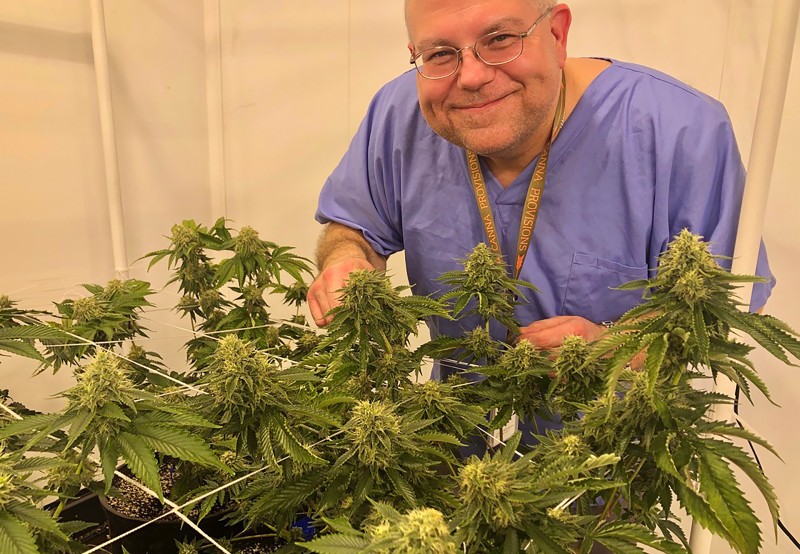What do you know about Chemdog?
Have you smoked Chem OG, Chemdawg, OG Kush, Sour Diesel, Stardawg, or any one of the many “dog-derived” strains circulating since the early 90s?
If so, you owe a great deal to a Massachusetts man named Greg “Chem” Krzanowski.
Chem is responsible for diligently protecting and tending to Chemdog, a beloved cultivar known for its happy, relaxed, creative effects and distinctive, diesel-like aroma. It’s also the progenitor of many of today’s most popular strains.
For thirty years, Krzanowski has lovingly cared for a Chemdog mother plant, cloning it again and again to preserve its unique genetics.
Now, for the first time, Chem is growing his beloved crop legally.
He recently joined Canna Provisions, a Massachusetts-based cultivator and retail business specializing in luxury strains.
In this exclusive interview, Cannabis & Tech Today sat down with Chem and the founders of Canna Provisions, Meg Sanders and Erik Williams, to discuss the future for the revered cultivar.
Cannabis & Tech Today: How did Canna Provisions learn about Greg “Chem” Krzanowski, and was it the man or the strain you were originally interested in?
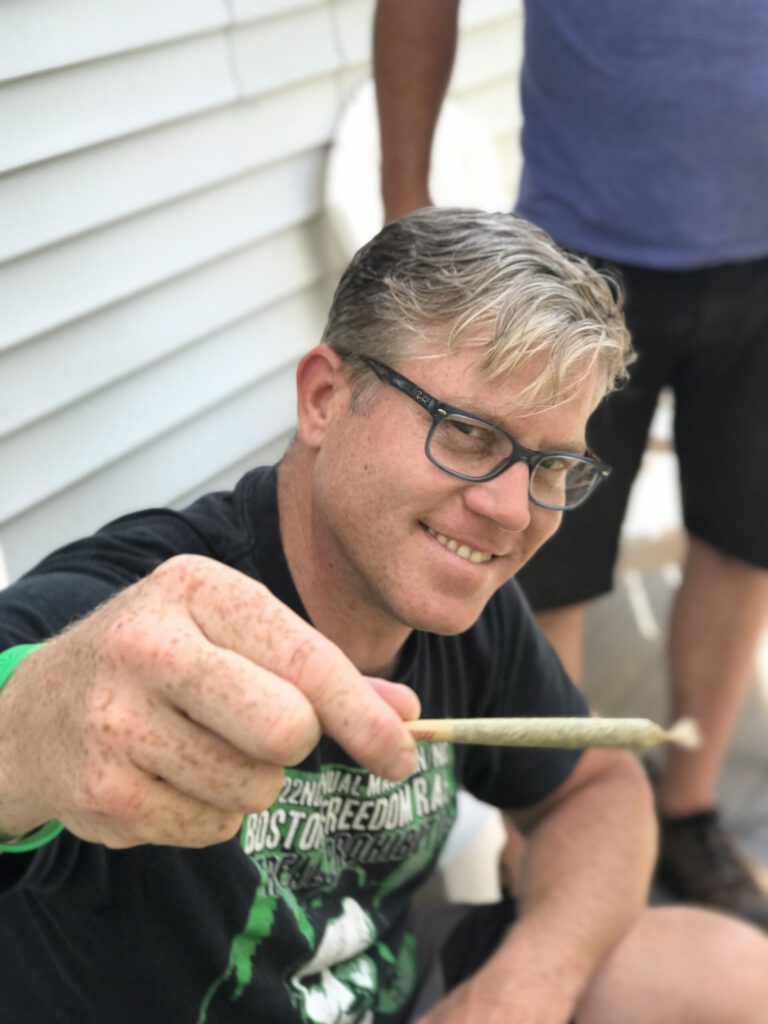
Erik Williams: First of all, Chem and I are just about the same age.
I learned about Chemdog as a legend, as the strain, way back in my late high school and college years.
That was the first time there was something different on the market.
It was rare that you got it and that’s when — I didn’t know until years later — that was also when the BC bud started coming out, which had deep roots in Chem as well, the strains getting out there.
And so it was years and years before I even knew there was a person behind it.
The Chemdog strain was such a legend to me.
And then once I got into the industry and really started getting to know a lot more people who geek out on genetics.
I mean, I like good weed just as much as anyone else, but I’m just not one of the people who geek out on genetics. And that’s when I started hearing a little bit more of the legend of Chem 91.
And we started hearing, well, Chemdog’s actually from Massachusetts and I was like, “What? Are you serious?” I didn’t quite understand it.
But then of course, the article in High Times that set the story straight came out.
By this point I had known that Chemdog was a person.
We met Greg because our chief marketing officer, I’d been reaching out to him to try to carry his glass.
And I’m sure you know Chem is an incredibly accomplished glassblower with sought after pieces, just amazing artistry.
And we went to meet Greg, and it was really just about carrying his glass at our store. Frankly, I wouldn’t have thought for a second to ask him to work with us.
I mean, it just seemed so crazy, the notion that could even happen.
But I’ll tell you, I’ve done a lot of cool things, Meg has as well in the cannabis industry, but I’ll tell you one of the coolest things I’ve done in the cannabis industry was smoke Chem with Chem.
I was just blown away by that.
Frankly, we just really hit it off in big ways.
I mean, I look at Chem as beyond a friend, he’s like a brother to me.
I feel like we are really compatible on so many of the things that not only are we passionate about, but we put our money where our mouth is for a long, long time.
And look, you can’t be in this industry without passion. It’ll just eat you up and spit you out.
It’s a tough industry to be in every day.
And really, I think that it was a matter of Greg and I connecting and telling them who we are and what we’re about.
And I know Chem’s had offers, dozens and dozens if not scores and scores to work with companies. And I was just blown away that he would even consider working with us.
We started talking, we made sure we were on the same page for ideals.
And Chem said to me, “I just want to grow the best bud possible. I want to grow great bud.”
I’m like, “Well, that’s the only thing we would ever hire you to do. Of course.”
I mean, the things that I could see Greg having to argue for or make his case for with other persons, I think he saw right off the bat that we were like, “Well, of course, yeah.”
It just, it made such perfect sense.
And then from there we had the conversation and we offered him the position of director of cultivation and we’re thrilled that he accepted, and it’s just been a heck of a wild ride since then.
C&TT: Of all the people you could have worked with Greg, why did you choose Canna Provisions?
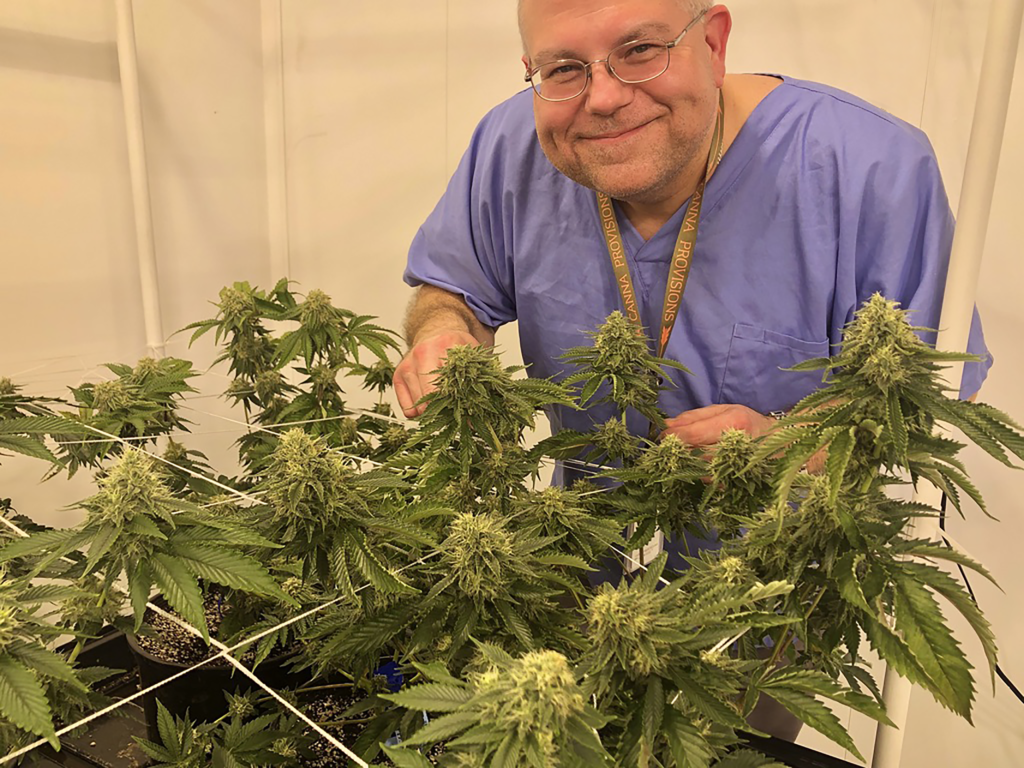
Greg Krzanowski: The first time I went to their place in Lee, I met Meg and Sean brought me there and the place is just beautiful, nicest dispensaries I’ve ever seen in my life.
But just that was the first thing I was like, “Wow, this is a really cool place.”
And then after I met Erik and Meg, we have the same vision, the same pathways in this whole thing, and I’m very passionate about this and everything just clicked together.
It’s because of Meg and Erik and the team that we have is why I’m here right now.
It’s a great team that we’re building, and I feel that our vision is just perfectly the same kind of vision I see taking off.
C&TT: When did you first become interested in growing cannabis?
GK: I grew my first plant when I was 16. I was in my brother’s apartment.
I’m like, “I’m going to grow a plant in your closet, just let me do it.” [Laughs]
And then I grew for a little bit, but then all his roommates started clipping the buds off the plants.
I’m like, “This is dumb, I’ll just wait to grow in my own house.”
So when I moved out of my parent’s house when I was 18, that’s when I originally started.
And that’s when I started to grow Chemdog.
I founded Chemdog when I was 18.
And that was the first, really the first true plant that I grew, that I took really good care of and went full force.
And actually I didn’t stop until I was 39, when I got in trouble. So I was growing half of my life at that point.
C&TT: When you first sampled the Chemdog strain, did you know right away it was special?
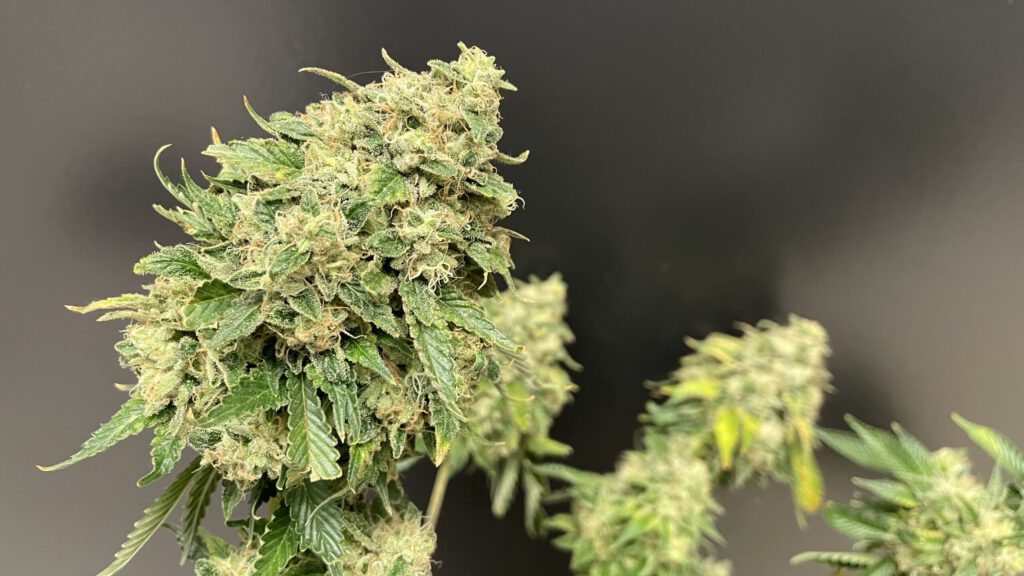
GK: As soon as I saw the bag and I smelled it, I knew it was something very special.
Then once I smoked it, I was like, “Wow, this is some of the best tasting pot I’ve ever smoked.”
It was just beautiful. I knew it was something special.
The question was, it was just a bag of pot at that point.
Thank God I had exchanged phone numbers with the people I got the pot from and linked back up with them about a month later, and that’s when I got some bud from them with an ounce of Chemdog and it actually had 13 seeds in it.
That’s when I was like, “I’m going full blow with this.”
And I was so thrilled that there were actually seeds from that bag, because I was like, “Wow, I think I just hit the lottery,” at that point. Little did I know…
I don’t know why at that point when I was 18, why I wanted to preserve it so much, but I just knew that it was something special and I’ve always had a passion for growing.
So I just went with it and thank God I did.
I did throw a male out in that first round, in the first four seeds I started.
So one thing I wish I didn’t do is throw that male out so I could make seeds of the original seed sack.
That would have been able to at least preserve a lot of seeds and made the original seeds back over again of some sort.
Since then it’s been cloning. I’ve had the same clone, I’ve only had the clone over and over and over again.
So I’ve had the same clone for, it’ll be 30 years this August. So we have that in a facility over here now.
C&TT: I’m sure it was difficult keeping an illicit plant alive for 30 years, through however many moves you may have made.
GK: Oh yeah, I had to move it. I moved from the first place I started it.
So I had to rent a U-Haul, and take a bunch of cloned plants in the back of this moving truck.
And back then,I was like 19 or 20 at that point.
At that point you go to jail for this stuff and I just went for it.
I’m sure you’ve just done the math here, but this is the 30th anniversary of it.
And so, 30 years later will be the first time you’ll be able to buy it legally.
And it’s a truly remarkable thing.
And I can speak for all of us very easily here — in ’91, no one was ever thinking this was actually going to be legal someday. They really were not.
So it’s a cool thing to do on a 30th anniversary.
My mom and dad don’t think I’m so nuts anymore. That’s for sure.
C&TT: As legal cannabis has rolled out in different states, was it surprising to see so many Chemdog-derived strains hitting the shelves?
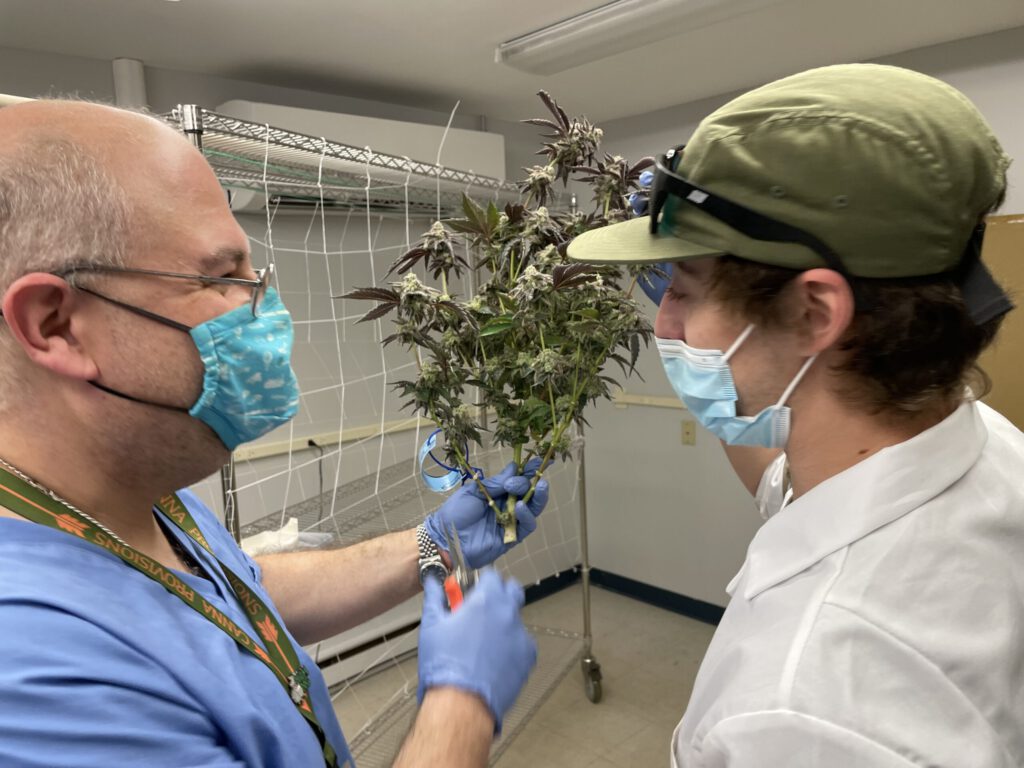
GK: It is everywhere. It’s in a lot of places. It’s been like that for a while now. I’m humbled by it.
I don’t mind it. I think it’s kind of cool that it’s in a lot of places.
It just shows that it’s a very well-liked strain out there that spawned off many other strains and many other hybrids that are out there.
And that’s why it’s on all the shelves in a lot of places, and it’s very powerful and it’s good smoke.
It’s good medicine, does a lot of good things.
EW: I’d like to just add to that real quick, one of the things that we’ve certainly found, all three of us, is there’s a lot of things that are labeled as a certain strain.
And actually having the lineage and tracing it back, a lot of times it just doesn’t happen.
I mean, a lot of consumers are not sure what something should actually look like, taste like, smell like.
And that’s one of those things that we see all the time.
I’ve seen it for years and years, something being passed off as something that I clearly know is not an original strain.
I can only imagine the frustration Chem goes through every day when he sees stuff out there, and just with his plant brain be like, “That is not what that is at all.”
This is where we can actually say for the first time, this is Chemdog, 100%.
How do you know? Because I’m Chemdog and this is the clone of the strain. That’s how I know.
GK: Probably 85% of the stuff out there isn’t what it really is labeled.
They’re just throwing the label on it to sell it, honestly.
I can take one smell, and I’m like “This isn’t it.”
Even just looking at it.
But once I look at it and smell it, a lot of it is not what it says it is out there. They just use the name.
C&TT: Greg, you own the trademark for Chemdog?
GK: Yeah. I do.
C&TT: Have you ever thought about calling out the imposters?
GK: It’s hard with the actual plant to trademark the strain because it’s out there everywhere, so I really couldn’t trademark that, but I had the name and the logo trademarked.
But, I have no problem calling people out, I don’t care how big they are. If they ain’t got what they say it is, then they should be called out.
C&TT: At this point, cannabis has been legal in many states for several years, why did you wait until now to debut your first legal grow?
GK: Meeting up with Erik and Meg and finding the right team to do it with, I’ve always wanted to do it in the back of my head, and like Erik said, I’ve gotten a lot of offers and a lot of things, it’s just not the right situation.
A, I didn’t want to move out of state. This is a perfect situation for me. It’s in my home state.
I was born and raised in North Hampton, Massachusetts, so it’s kind of like central Mass.
The stores are great, these guys are great, their visions are on the… We’re all on the same page.
It was like everything clicked together.
It was almost like a picture.
It was almost like getting linked up with your long lost brother, and just going like… I don’t know, it was just, it was a perfect situation that needed to be done. That’s what I’m here for.
C&TT: What’s been the most exciting part of getting to grow legally for the first time in thirty years?
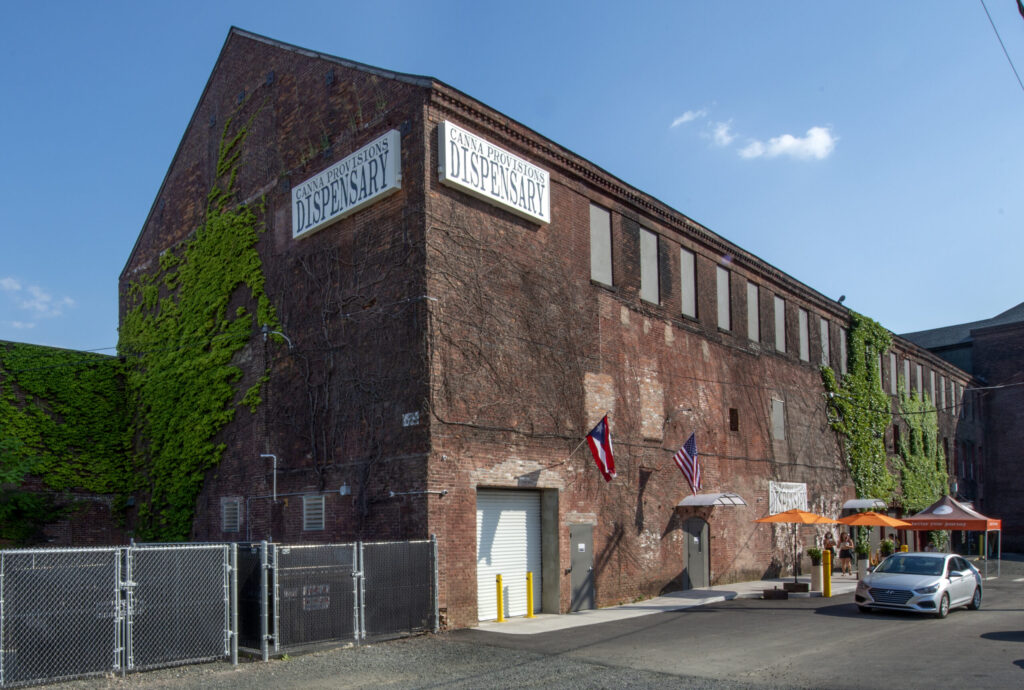
GK: Growing plants and not getting in any trouble for it. And we’re going to bring some really good things to the people of Massachusetts, for sure.
EW: I’ll even just take a look at some of the pictures of Chem in the grow. You can’t fake that smile.
And I’m walking through and I mean, I get the same smile too when I’m in there and smelling stuff and seeing the expression of the plants.
I mean, look, it’s a job well done.
I mean, getting just that notion of look what I’ve done, look what I’ve grown, look what I’ve created.
That’s a really cool thing for everyone. And this is just a… I know I’m speaking for you, Chem, but this is a true culmination.
GK: I agree.
C&TT: Is cultivating the plant in a legal setting influencing the plant itself? Perhaps you can spend more time on R&D or look closer at the genetics than maybe you’ve been able to before.
GK: Oh, for sure. The facility, we have a very high tech facility.
Everything is just there at our disposal, so there’s a lot of research. There’s plenty of time to do research. You have the space, the tools to do it. So we’re going to perfect it, once we get everything dialed in.
So there’s definitely a difference growing in the legal market versus the illicit market.
You’re more open about things. You can get things accomplished without looking over your shoulder and dealing with bringing soil to your house and all that stuff.
You can do a lot more research and development. You have a high-tech facility, it makes a big difference.
EW: And the scale, I think, is one of the biggest things that comes with this.
If you only got a small space, you’ve got to be really careful and it’s time consuming as to making any kinds of changes.
But if we’ve got something and we’ve got 60, 70 clones that we’re putting out of a single strain and we want to make a change in it, we can actually make that very specific change in a few plants.
And instead of having to wait multiple generations to see results, we’ve got side-by-sides right next to each other, for changing only one input or one thing that we’re doing, or changing one little thing.
That’s the very definition of R&D and the more data points, that’s the key, is having many, many, many more data points.
So, I mean, in our facility right now, we’ve got like 15 different things that we’ve got that are R&D. In a home-grow, having 15 different R&D things going on is just impossible.
C&TT: How are you using new technologies to streamline your processes?
EW: Well the main point is collecting data points as much as we possibly can. And right now, as we’re harvesting our first harvest tomorrow, one of the things that we are intent on doing is first of all, capturing the art side of things.
So whenever you’re starting a new grow, you definitely want to dial it in, meaning spend the time.
It’s not like you hook everything up to dosatrons on day one and just run it. You need to get in and do the hand water, and you need to get in and see everything that’s happening.
And then dial in and say, from all of these data points, these were the ideal conditions.
Once you start to do that, you start to use the best practices as you possibly can to find out exactly where the efficiencies are.
This is industrial agriculture. A lot of the things that we’re using have existed in industrial agriculture for a very long time.
And so we’re doing the adaptability of taking the art of cannabis growing that comes with the knowledge from Chem and using the science and the technology of existing agricultural practices.
What we’ve seen in agricultural practices across the board is people being able to make the investment in figuring things out, because it is such a high value crop, having an extra 5% yield is significant.
And going after those extra percentages, it’s worth a significant investment.
Getting tomatoes that are 1% larger, that’s not necessarily the investment worth making.
But sustainable practices are incredibly important, dialing in exactly how much water we’re going to be putting in, making sure that we’re dialing in our electrical systems and our HVAC systems in a way to be efficient.
The Commonwealth is the best in terms of energy efficiency in the entire country, and they are not letting the cannabis industry throw them off on that.
So we’ve got strict guidelines that we need to follow. And just like anything else, it’s dialing in every single bit of efficiency, how can we get at the retail store?
How can we make the transactions more efficient at any given time? Are we taking extra steps?
What’s the best way to water and not have it take an extra 20 minutes?
We talk about Kaizen in our company, which is a Japanese term and it means essentially constant improvement.
It also, by the way, means that nobody’s perfect because you can’t have constant improvement of perfection.
So it’s a little more of a philosophical thing, but it is the little things that we’re looking at every single day, the best lights, the best nutrients that we’re putting in, the best times to trim or the best times to harvest, the best times to take clones.
Every single bit of it is all based on collecting data points.
C&TT: Chem, how did your arrest in 2011 shape your view on the plant and the industry?
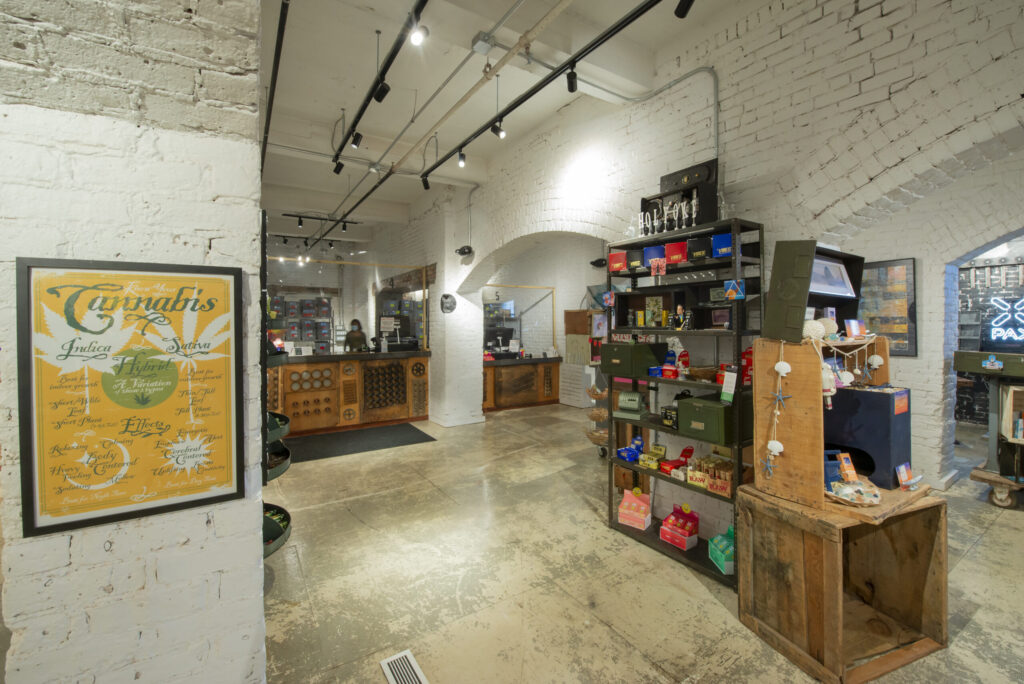
GK: It took me a little while after that experience to even want to be around the plants for a little bit.
It’s the year I was a little shaken up a little bit.
It definitely made me think about all the other aspects of the plant and stuff that come with it.
And I think in a way, it didn’t help me, but it just formed me to be where I am right here today in this situation for sure.
I had to forfeit a lot, a lot of money, six figures and lost cars and everything else. So it was a rough thing.
But to be able to be in this position I am now, that Erik and Meg allowed me to be in this position to do this for them, it’s definitely a great feeling now.
It was hairy back in the day, back in 2012 and ’13 after going through it all, just not knowing how the outcome of all the laws were, what was really going to go on.
I think that getting in trouble put me in the position where I am now, to do what I am doing.
I’m not sure where I would have been if I didn’t get in trouble… not in a bad way, just where I would have been, would I have kept growing in my home and just stayed like that?
I think it put me in a position to be in a legal market, do what I want to do and do it legally.
EW: I would just like to add to that because I think this is a really important point.
There are still people serving time and we’re very lucky to be here in the Commonwealth, but there are states where… We almost take for granted that, of course there’s medical out there, of course you can get this if other things have failed you, but right now there are still medical refugees across the country.
There are still people who are going to jail, who are having their lives ruined for this plant. And so I appreciate that every single day.
And frankly, looking at Chem is a reminder to me as well. We were not done fighting for the big things at all. We’re just not done fighting to free the plant, frankly.
I know personally I’ve had several interactions at our store in Lee where grown men have cried on my shoulder saying, “This is amazing. I served time for this.”
And they’re looking back at their lives and be like, what the hell happened? And it’s not difficult to find those stories at all.
There are so many people who had their life ruined, not because of the plant, but because of the horrendous racist policies behind the drug war on the plant.
C&TT: How do you envision the future of the industry?
EW: Well, I mean, look, the industry is going to get… It’s going down the same path that it has been for some time. I think that there’s going to continue to be the biggering and biggering of the businesses.
But I think that there’s also, it’s going to mimic the alcohol industry more specifically, almost like the beer industry. That’s how we’ve envisioned this coming out.
It seems to be playing that out. We’ve been saying this for 10 years. And within that, there’s always going to be people who are just looking for the Bud Light.
And there’s going to be people who are looking for the Sam Adams and then person two are looking for those $22 four packs of some really rare brewery.
And you need to exist on all sides. I mean, the industry is going to exist for all of those consumers. And for us, we want to answer the question every day, what do we want to be in that?
We’ve got the aspiration to be something different, something better. That’s why Chem is part of our team. That’s why we value him as part of our team.
And yeah, we think that you can do really well by doing good, but we also, we’re not stupid, we know that there’s people that don’t subscribe to that behavior.
And that understanding, we want to be able to compete with them. And the best way to compete with them, we believe, is through the single best products, the best customer service, and unique products.
And we’ll let other people pump out the Bud Light.
C&TT: Are you excited to hear feedback from customers on your first legal crop? This is really the first time anyone can purchase Chem and say with confidence that’s what they received.
GK: Of course, that’s one of the most important things I’m looking forward to, is seeing people’s reactions to this.
And I want criticism. I take criticism’, good and bad. If it’s bad, I want to know what’s bad about it.
So if it’s bad, if it’s something that we did, we can fix for the next time, but hopefully there’s not going to be much of that going on. I’m coming in to try to hit things out of the park for these guys.
Author
-
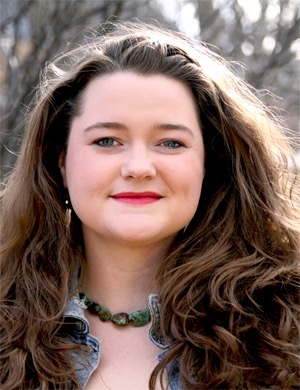
Patricia Miller is an executive editor at Innovative Properties Worldwide. She explores science, technology, and policy shaping the legal cannabis sector. Follow her work when you subscribe to Cannabis & Tech Today at cannatechtoday.com/subscribe/ or visit her website https://patriciamiller.squarespace.com/.

